I wish that I were a poet as I would certainly write an ode to tamales. If you have my cookbook The New Fast Food, you will find an Ode to the Pressure Cooker poem written by a good friend, Laurie Reaume. I won’t repeat it here, but it’s good. Instead of writing that ode, I will share with you my tamale-making experience and you will be able to tell that I have a “thing” for corn – organic, non-GMO corn, in its many forms and formats.
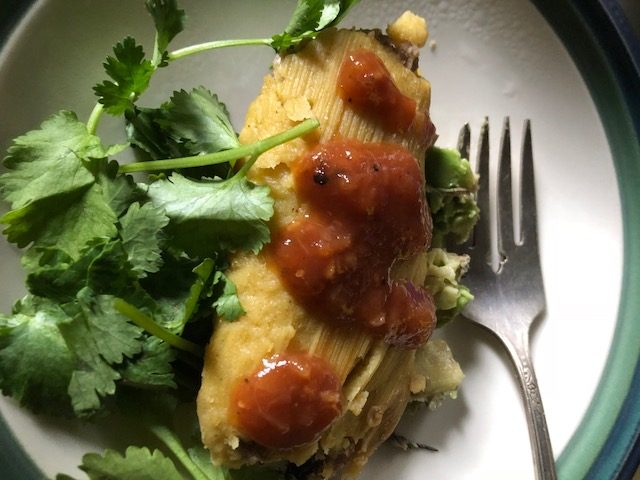
I posted on Instagram (@theveggiequeen1) that I love corn and that I made tamales, although tacos are much easier. Someone said that they hadn’t made either which made me think, “Could I exist without tacos?”
I doubt it.
I almost always have a package of organic corn tortillas in my freezer. I buy a very large package of Mi Rancho organic corn tortillas at Costco. Then I take them out of the package, put strips of waxed paper between each tortilla and bag 15 or so, and put them in the freezer. I take them out when I want to use them. You can easily steam them in your pressure cooker or just put them in the microwave for 30 seconds.
Then I fill them with what’s in my frig. A typical filling is some kind of bean, often black or pinto, but it could be Anasazi or Jacob’s cattle, potato or sweet potato. I then top my tacos with either hot sauce (often one I have fermented) or salsa, avocado (when I have a good ripe one – avocados and I are on the outs these days), onion and cilantro, maybe a squeeze of lime.
Tacos couldn’t be easier, but tamales…oh my…not so easy but oh so tasty, and, for me, worth the effort.
My husband was going out of town and I needed to check out my new Mealthy Mulitpot 2.0. With that in mind, I bought some organic masa, planning to tackle the task of making tamales. I dragged my feet for most of the tamale-making day until finally, I had to do it.
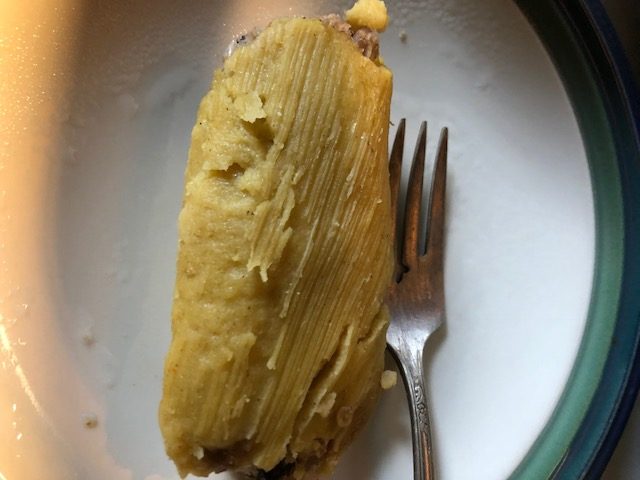
How To Make Tamales
Jump to RecipeSo I started with the filling — a mix of white beans: Alubia Blanca from Rancho Gordo, great northern beans and appaloosa beans.
You might ask why the combo? It’s how I roll, and I only had a small amount of the RG beans and the appaloosa and I wanted something other than just white beans. It doesn’t matter which beans you use but you will need a total of 1 ½ cups. I did a quicker soak: 3 inches of water above the beans, a 3 inch piece of kombu seaweed, set my pot to 0 and low pressure and waited for the pin to drop which takes about 20 minutes in my Instant Pot mini. I let them sit for a while longer.
And then I cooked them. Added some chili powder, adobo seasoning (from Frontier), about a teaspoon of cumin seeds and that was it. I cooked them for 8 minutes. When I opened the pot, I added dried onion and dried garlic and a bit of salt. (Didn’t measure these). I let that sit for another 10 minutes and then moved along to the masa dough.
Before I put on the beans, I added about 15 dried corn husks to a large bowl. I covered them with water and then set a plate on top of them to weight them down. I wanted them to sit for at least an hour but it was more like 3 hours.
I made oil-free tamales last year and they didn’t go over well in my house. If I am going to bother making something as labor-intensive as tamales, they must get eaten. So these do have added fat. It works out to less than 1 teaspoon per tamale. I read that you can make them without any oil (there are at least 3 ways – Kathy Hester uses pumpkin, Chuck of Brand New Vegan likes to blend a can of corn and another blogger just uses more liquid). I used Spectrum shortening because I had it left from making tamales another time.

Now for the recipe. I wish that I had taken more photos but it’s hard when your hands have been in masa and I was alone. I can tell you that if you seek perfection in your tamale making, you might want to let go of that notion the first time you make them. I believe that there is a learning curve. And they will likely taste great even if they don’t look so good.
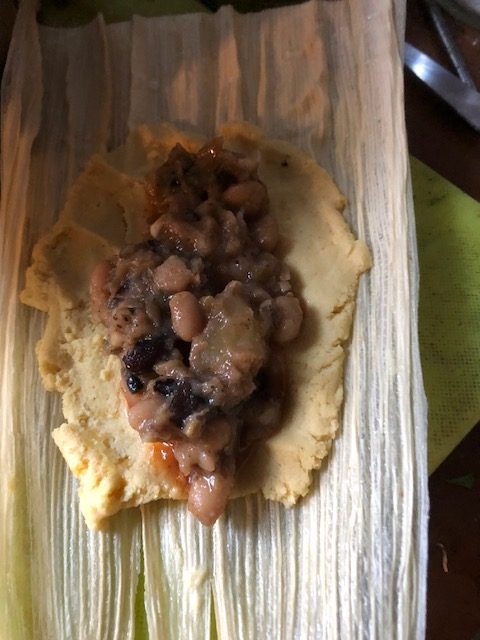
To Assemble
- Gather your soaked corn husks. (Soak them for at least and hour while the beans are cooking.) Drain the corn husks, one at a time.
- Have your filling nearby.
- Put the corn husk down with the pointier end toward you and the wide end up. Starting about half-way up the husk, flatten out your ball of masa into a rectangle with the narrower part at the top and bottom. (most likely 2 inches by 4 to 5 inches although not being an engineer, I didn’t measure. I barely eyeballed it.) Take about 2 tablespoons of filling and place it neatly in the middle of your rectangle. (this is where things get interesting) Add one half to 1 teaspoon salsa down the middle, if desired. Then fold over one side of the husk to envelop the filling. Then fold over the other side until you have a sealed husk. Tear one of the not-so-good husks into long strips. Fold up the pointy end of the husk and then tie it with a strip of husk.
- Put into a steamer basket in your pressure cooker which is over 1 ½ cups of water. (The Mealthy comes with a steamer basket but it needs to be elevated off the bottom of the cooker.)
- Repeat with the remaining dough and filling and salsa.
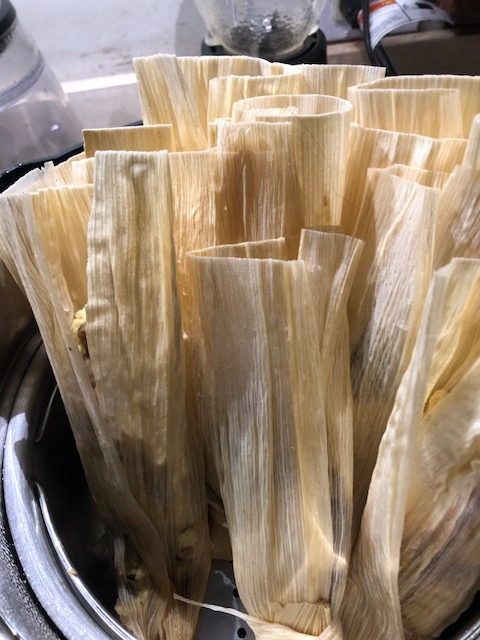
To Steam
- When you have used all your ingredients. Set your pressure cooker for 25 minutes and let the tamales steam. When time is up, let the pressure come down naturally. Open the lid carefully, tilting it away from you. Carefully remove the hot tamales.
- Let them cool for a few minutes before removing the husk and eating.
Note: These freeze well but let them cool before freezing. You can cook them from frozen in the pressure cooker on steam for 10 minutes.
Making tamales is a labor of love but if you love them like I do, you will find it worth it. I believe that your skill will improve the more that you make them. (I am sure, though, that I do not have tamales in my genes and that there are many people who can do a better job with them than I do.)
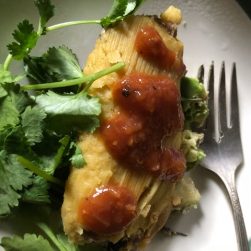
White (or other) Bean-Filled Tamales
Ingredients
Bean Filling
- 1 ½ cups beans soaked and drained
- 1 – 3 inch piece of kombu seaweed
- 1 to 2 teaspoons cumin seeds
- 1 teaspoon mild chili powder
- ½ teaspoon hot chili powder or more regular chili powder
- One half to whole 4-ounce can of roasted green chilies if you only use half, freeze the other half for the next batch of tamale filling
- Diced onion and garlic optional
- ¾ cup liquid such as water
Masa
- 2 cups organic corn masa harina must be labeled masa not cornmeal or corn flour of any kind
- ½ teaspoon baking powder
- ¼ to ½ teaspoon salt
- 1 ½ cups vegetable broth or water mixed with 1 teaspoon chicken broth powder heated or good vegetable broth
- 3 tablespoons vegetable shortening or oil such as sunflower or grapeseed oil
- Salsa for each tamale if you want it
- 12 Corn Husks
Instructions
Bean Filling
- Combine all ingredients in your pressure cooker and cook on high pressure for 8 minutes.
- Let the pressure release naturally.
- If you didn’t add onion or garlic, now add 1 to 2 teaspoons dried or dehydrated onion and garlic.
- Stir in and let sit for at least 5 minutes.
Masa
- In a large bowl, mix the masa, baking powder and salt.
- Combine the warm water with the shortening or oil.
- Pour into the masa and mix with a fork (or anything you like) to get it combined.
- The dough should not be sticky nor too dry. It should not stick to your hands. If it does, add more masa. If it seems too dry, add a bit more liquid. Mine was a bit sticky at first but I let it sit 10 minutes and it was perfect to form into balls of about ¼ to 1/3 cup each.
To Assemble
- Gather your soaked corn husks. (Soak them for at least and hour while the beans are cooking.)
- Drain the corn husks, one at a time. Have your filling nearby. Put the corn husk down with the pointier end toward you and the wide end up. Starting about half-way up the husk, flatten out your ball of masa into a rectangle with the narrower part at the top and bottom. (most likely 2 inches by 4 to 5 inches although not being an engineer, I didn’t measure. I barely eyeballed it.)
- Take about 2 tablespoons of filling and place it neatly in the middle of your rectangle. (this is where things get interesting)
- Add one half to 1 teaspoon salsa down the middle, if desired.
- Fold over one side of the husk to envelop the filling. Then fold over the other side until you have a sealed husk. Tear one of the not-so-good husks into long strips. Fold up the pointy end of the husk and then tie it with a strip of husk. Put into a steamer basket in your pressure cooker which is over 1 ½ cups of water. (The Mealthy comes with a steamer basket but it needs to be elevated off the bottom of the cooker.)
- Repeat with the remaining dough and filling and salsa.
To Steam
- When you have used all your ingredients. Set your pressure cooker for 25 minutes and let the tamales steam. When time is up, let the pressure come down naturally. Open the lid carefully, tilting it away from you. Carefully remove the hot tamales. Let them cool for a few minutes before removing the husk and eating.
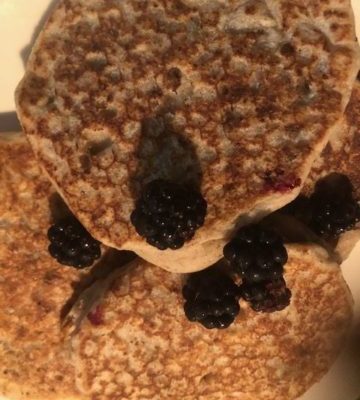

I have not been able to find organic corn husks. Wouldn’t the regular ones be full of GMO’s?
Marlene,
I have a concern about this too but we have to do what we have to do. And it seems better and safer than using foil or banana husks. It’s jut not a perfect world. You already know that.
I cant wait to try this out. I LOOOOOVE tamales and you cant just go out and get them here (American living in the UK). I have been contemplating ordering (from Amazon probably) some corn husks and masa and you have convinced me to do it! I do have a question tho, why the kombu seaweed? I am not familiar with it and as you might guess not readily available here. I bet the answer is in your book. I cant wait to receive mine. So glad I saw you on Chef AJ’s live show yesterday.
Sorry for the delayed reply. I add kombu seaweed which might have another name in the UK. I believe that it grows at the coast in the cold waters of Scotland. It adds minerals and helps potenilly relieve gassiness in beans.
Thank yo for tuning in Lori.
I like this kind of recipe, it’s clever, simple and so delicious to taste.
When I took a look at the back, I got ho it looks complicated to me !!! And then after having read everything, I discovered a marvel of ingenuity. It’s about the organization, but I am very envious of this recipe that I do not know at all.
I would like to know that it is its origin?
All my thanks …
Really great, Jill! Fun writing, critically important topic. My 1980s restaurant, The Catalpa Tree Cafe was most famous for its Catalpa Tree Burrito, and vegetarian corn and bean based burritos are the staple of my diet. They are my favorite breakfast.
I am making the Heirloom Meatless Recipes website now, and will send you a draft to review.
Wonderful Wendy. I will share your info as I can.